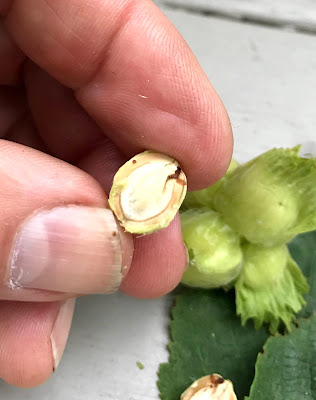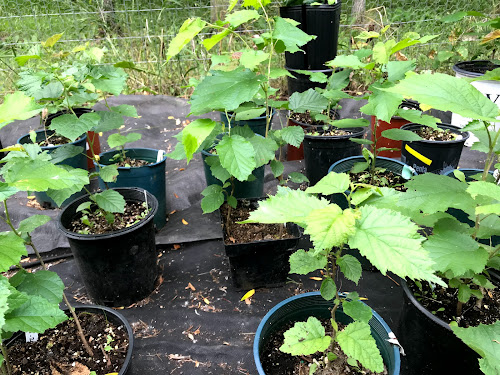An Unusual Spring

This year the flowering occurred on April 25, is 2 weeks later than normal, and only lasted 2 days before it cooled down and rained. Hazelnuts are wind pollinated and need a week of warm, dry weather for the male catkins to expand to release pollen, and for the small female sigmas to appear on the buds to receive the pollen.
The plants that were hand pollinated did fine, but because of the many different hazelnut varieties in the orchard they need about a week to pollinate all the different flowering times of these various plants.
Some plants had no nuts, but most had few, and one or two had a good seed set. The plants with the most nuts were more of the wild American Hazelnut varieties. This is probably due to fact that they are the first to bloom, and the later blooming hybrid hazelnuts need a longer pollination period.
This shows last year's crop from one plant, which would fill a grocery bag.
This year I've been getting far fewer nuts, just a handful from my best plants.
This is one of my better hazelnut plants that produced a lot more nuts than I expected, but still far less than previous years.
The nuts on this drying rack are another plant that had a lot more nuts also, but ripened late and I had to spray a lot of pepper spray to keep the squirrels off of them to let them ripen up.
This is almost the entire crop of hazelnuts for 2020 drying down in the greenhouse.
Here we have a few of the different size nuts from this year's crop.
As you can see, some of these plants that produce the smaller nuts will have to be removed and replaced with more of the new hand pollinated seedlings.
Repotting Seedlings
In the spring when the seedlings are moved outside they are transferred from the tubes to larger pots. I was little short on potting soil so I used mostly compost mixed with a little purchased potting mix. The mixture was probably a little too hot due to the new compost, and it turned the leaves dark green with burnt edges. In a week some of the leaves turned brown and fell off.
I thought at first it might be some type of herbicide damage, but now I'm sure it was the new compost I was using for potting soil. Lesson learned!
My only hazelnut graft that worked from 2 years ago is still holding and produced 2 nuts this year.
In search of hazelnuts
I found this hazelnut with a leafy type of husk in Spicer MN on a bike path on July 11, 2020.
This American hazelnut was a little different with the open husk and visible nut in side.
As you can see the nut was small with a thick shell.
I found these hazelnut plants while hiking in Glendalough State Park on August 4th.
Hazelnuts found there had a totally enclosed husk that was round, juicy and slightly sticky.
This is a more typical type of American hazelnut husk.
The nut easily roll out of the husk so it was ripe and ready to be picked.
The nut was not round but more of a oval flat shape, which is very undesirable for cracking.
The nut had a thick shell and the kernel was a flat bean shape, and tasted quite bitter.
Pecan trees
I would like to thank Derek Jundt for the 6 pecan seeds he sent me last year. I stratified them in the fridge and germinated them the first week in March. I was surprised that all 6 seeds germinated, but one didn't make it after transplanting them outside. It will be interesting to see how well they do in our heavier soil, and our winters.
I also received some butternut seeds from Bill Miller in Aneta ND. Only 2 germinated and after transplanting them a rabbit clipped one off before I could put a cage around them, but the one Butternut is looking good.
Thanks Bill!
Cloning using a Hog Ring Pliers
https://youtu.be/2ZcjcGbtp9s
I'm hoping this video that I made of layering using a hog ring pliers works.
This is my first attempt at making a video and it might not be great but I think shows how I clone hazelnuts.





















nice update, thanks
ReplyDelete